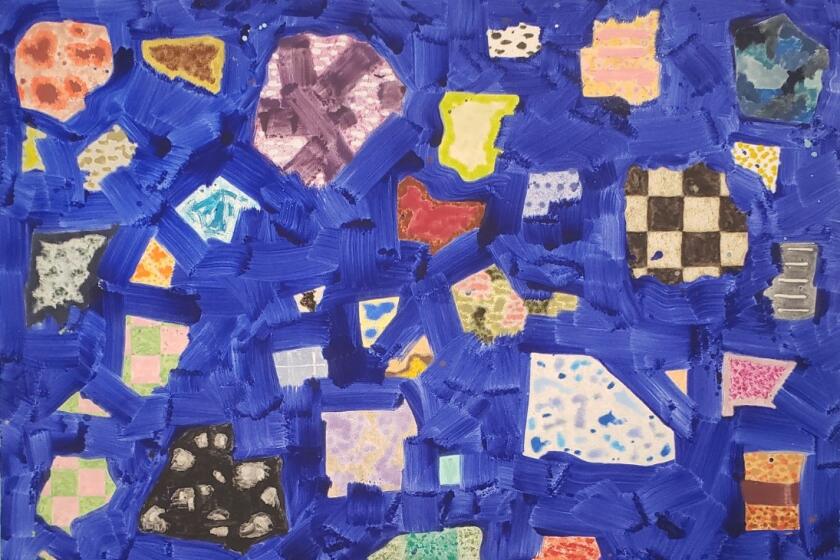L.A. artist Alexis Smith upended taboos. A thrilling new museum exhibition shows how
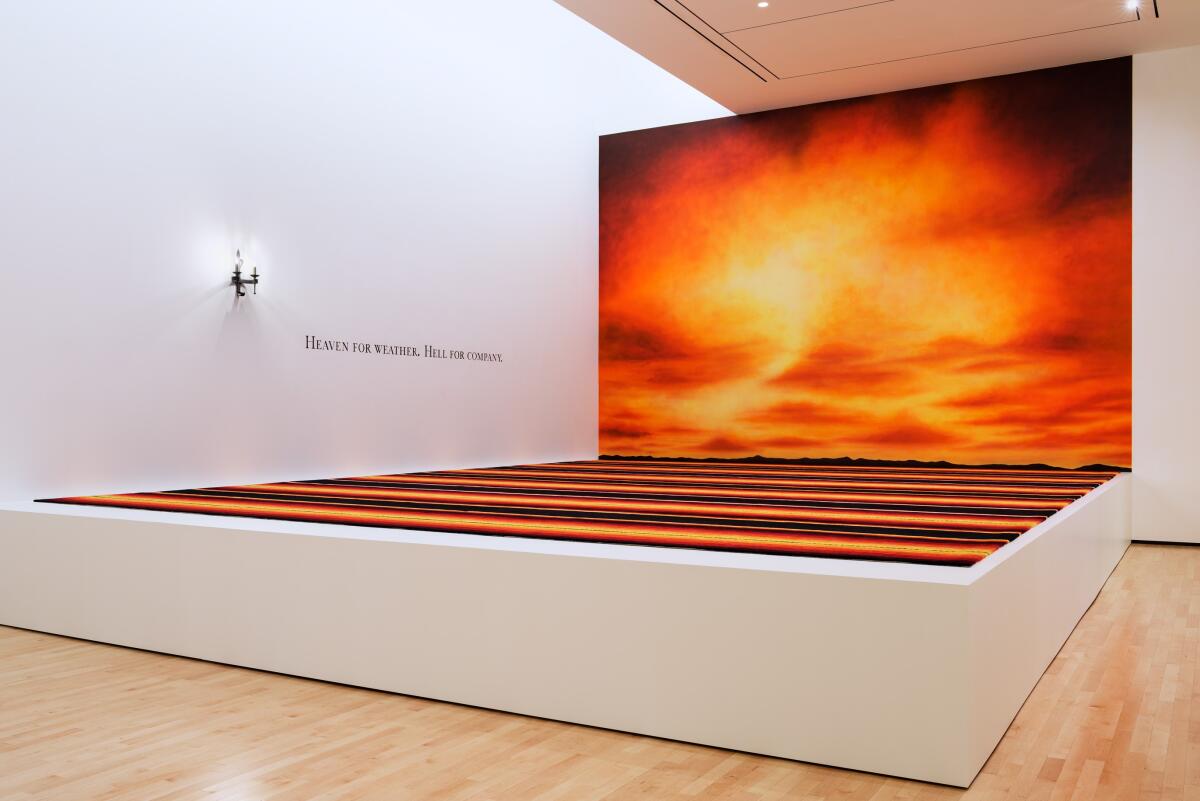
- Share via
LA JOLLA — When Alexis Smith began to make art as the 1970s launched, two taboos apparently proved irresistible. Judging from the persuasive evidence in a marvelous, long-overdue retrospective of the Los Angeles artist’s exceptional career, she went straight for them.
One prohibition was against embedding literary qualities in art. Writing was writing, art was art, and never the twain should meet.
Tensions were running high between the inescapable incursions of messy mass media, pushing its way into every facet of modern life, and a worn formalist conviction that every artistic medium should be pure and vibrant unto itself. In this crabbed and narrow view of things, the prime offender was the Pop art typified by Andy Warhol, whose 1970 retrospective caused a hubbub at the organizing Pasadena Museum of Art.
The other restriction, not unrelated to the first, was a second-class status reserved for some artistic media. Painting and sculpture held firm at the top of the heap. Then there was the rest.
Somewhere below art’s pinnacle could be found ceramics, graphic art, weaving, photography, collage and more. Painters and sculptors had the capacity to be the great artists, the thinking went, while everybody else was irretrievably stuck being everybody else.
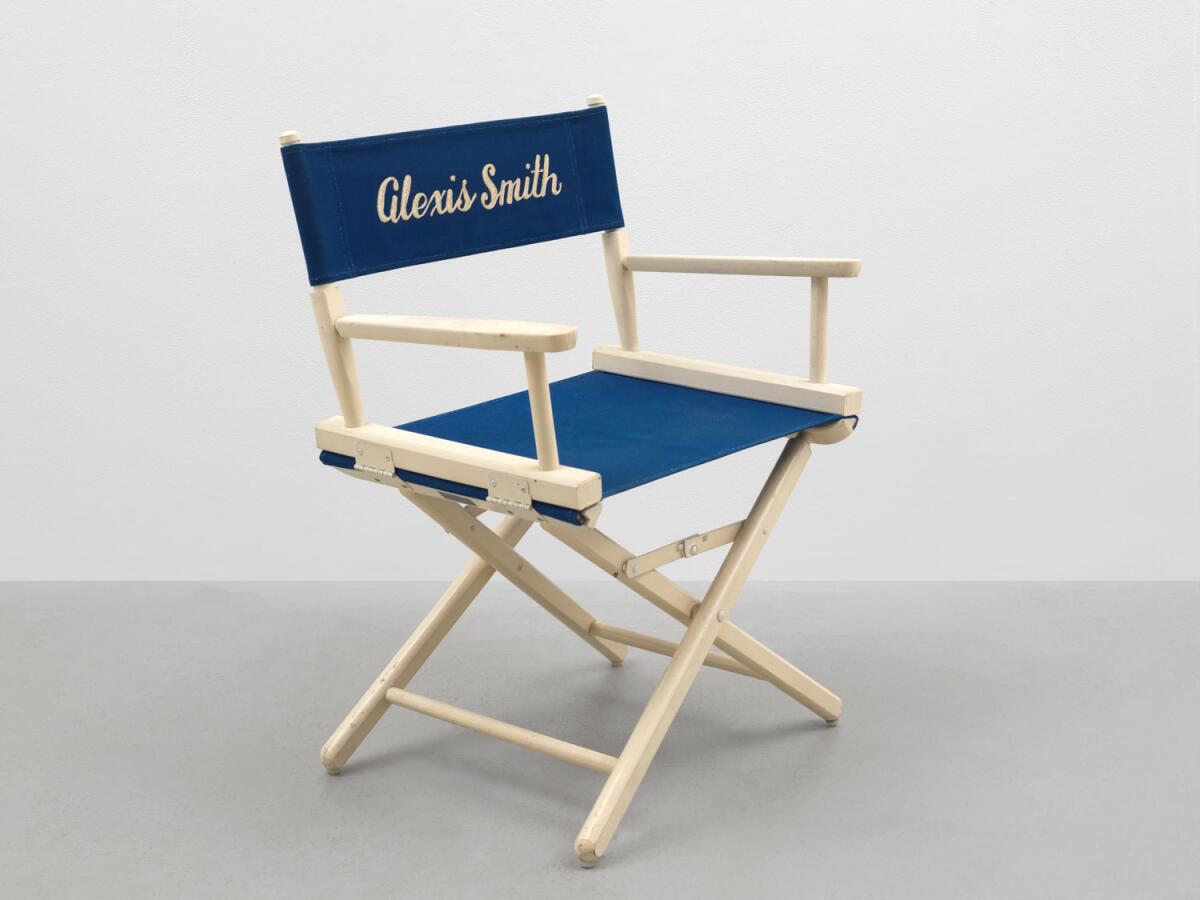
Smith, with a curious mind and an acute design skill, began to make literary collages — two taboos in one. Her wicked sense of humor helped ease a viewer into the maelstrom. Sheets of paper typed with excerpts from Jorge Luis Borges, John Dos Passos or Walt Whitman and punctuated with attached pictures, decals and objects were boxed in plexiglass, like disassembled books of cheeky poetry. Salvaged thrift-shop paintings, posters and photographs sporting collage elements and screen-printed text were set in elaborate picture frames, their design integral to the art rather than as a decorative support for it.
Finally, collages that were fully environmental began to spill across entire walls, fill whole rooms or even spread around outdoor sites in the landscape. Immersive installation in the early 1980s put the artist at the forefront of a major, now commonplace development in the art of the last four decades. Illness forced Smith, 73, to cease making work about six years ago, but the engrossing retrospective underscores her pivotal importance.
The stage is set in the earliest work among the 51 gathered for “Alexis Smith: The American Way,” deftly organized by curator Anthony Graham at the Museum of Contemporary Art San Diego, where the show is on view through Jan. 29. From 1971, the year after she graduated from art school at UC Irvine — Robert Irwin and Vija Celmins were two mentors — “Colorado” is an altered school yearbook held in a handmade wooden binder.
Shown on a pedestal, the book is open to a page displaying 56 anonymous head shots laid out in seven neat rows. The facing page, mostly blank, features a small, stenciled figure of a woman, arms and legs akimbo and repeated several times, as if falling through the empty sheet’s void.
Like that mystery woman in free fall, all those nameless, unidentified, neatly scrubbed and often goofy-looking graduates are about to be cast out into the unknown — just as Smith herself was as she left school. The work’s veiled autobiographical dimension is given a twist by the artist’s own name: Born Patti Anne Smith, she chose at age 17 to assume the moniker of an accomplished if not quite superstar Hollywood actor. Alexis Smith’s ultra-common last name classified her as a kind of Everywoman.

The show biz bona fides firmly located modern experience within the dizzying hall of mirrors that is the mass-media madhouse. Another 1971 collage, not in the show (but once owned by the actor), shows gritty determination: A clipped publicity still of the aspiring star is tucked in an envelope marked “Ma-chees-ma,” a feminized phonetic appropriation of the Spanish word for aggressive masculine pride.
The exhibition’s first gallery features a tantalizing face-off between a sculpture and a collage. Both are simply fabricated from commonplace objects.
The sculpture is an ordinary canvas folding chair, the stereotypical kind that directors or actors might find on a soundstage with their name emblazoned across the back in script. It’s a reserved perch from which the labor of creating art — and a public identity — takes shape.
On the wall opposite hangs a machine-printed “painting” of wild horses galloping in an unfettered stampede, kicking up a cloud of dust that captures light and bathes the Western scene in a golden glow. On it is affixed the famous album cover for the record “Set Free,” designed with a photograph of a crouching Patti Smith, the feral punk rocker with whom the artist happened to share a birth name and whose breakout song and album were titled “Horses.”
In works like these, Patti Alexis Smith — the artist, not the actor or the singer — creates cultural wormholes of uncanny effect. Her mordant social commentary is lodged between the glamorous fizz of Warhol and the tatty thrift store aesthetic of Mike Kelley. Slip-sliding collisions of image and text in works by artists like Edward Ruscha and John Baldessari provide a tart context.
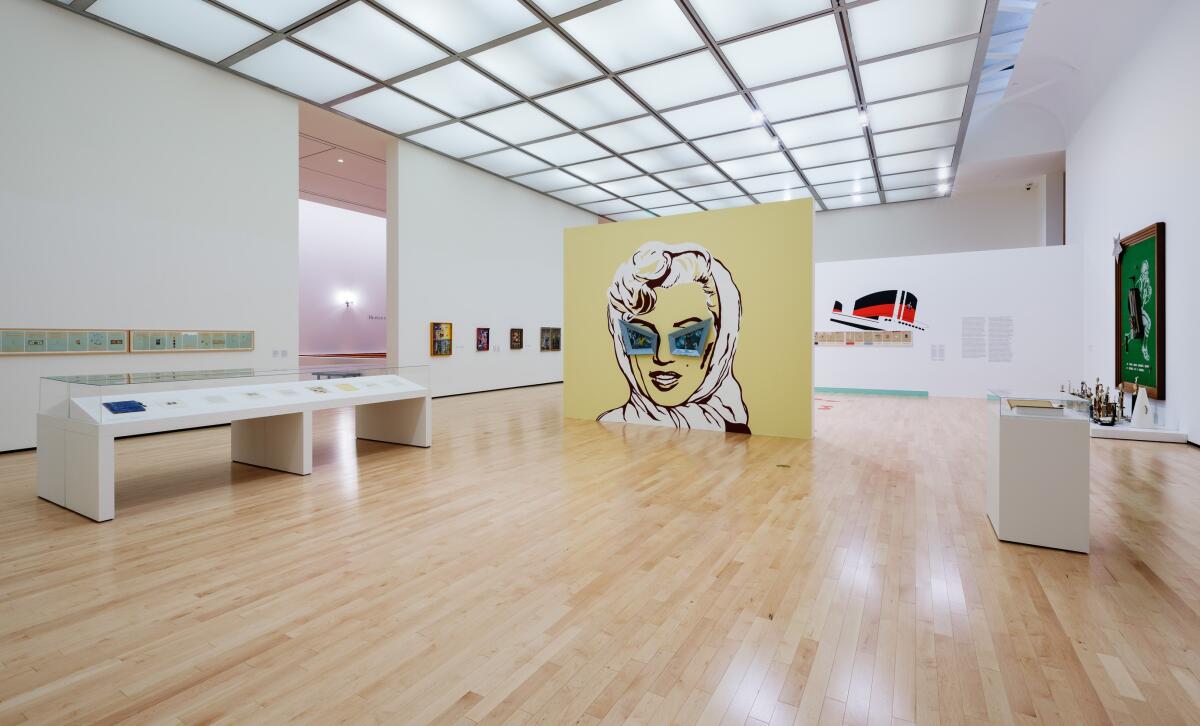
All these artists were keen on undoing the stifling prescriptions of modern art, high or low, entrenched within a mass media environment dependent on the choking proliferation of stereotypes and cliches. For Smith, second wave feminism of the 1960s and 1970s provided crucial fuel, with sexual politics a recurrent theme.
Those politics are almost always embedded within Smith’s sharp sense of absurdity, salted with the specter of eventual injury and loss.
The “Colorado” yearbook also includes a period cheesecake photograph that looks like the other Alexis Smith, her bullet-breasted two-piece bathing suit ambiguously greeted with the stenciled word “guffaw.” In a wall-size mural, “Isadora,” painted on cheap, disposable corrugated-cardboard, dancer Isadora Duncan’s liberated choreography leads to vanguard artistic celebrity and ultimate strangulation, the long scarf wrapped around her neck fatally caught in the axle of a car.

Car culture, as leaden an L.A. cliché as exists, turns up often. The two thematic collage-posters in “Blue Denim,” each advertising drive-in movies warning of the dangerous pleasures of teenage lust, are slyly linked together by a set of automotive jumper cables. Stand back, as electrocution competes with the spark of rebirth.
In “The 20th Century,” a B-movie poster is screen-printed with the legend, “I’ve died so often, made love so much — I’ve lost track of what’s real.” Haven’t we all?
The exhibition presents half a dozen trenchant installations, including “Red Carpet,” a 2001 commissioned work for New Mexico’s SITE Santa Fe. Taking the original location into account, the gaily serape-striped rug is patterned after a tourist souvenir, and it leads to a nearly abstract wall mural of flaming red-orange hues that signals either a glorious sunset or a wildfire’s deadly inferno. Stenciled onto the adjacent wall next to an incongruously glowing sconce is eternity’s conundrum: “Heaven for weather, hell for company.”
Unfortunately, one can no longer walk out and loll about on the Hollywood carpet, as was possible in Santa Fe. But La Jolla is a good place for the retrospective, because two monumental Smith masterpieces are permanently installed nearby at UC San Diego. They’re worth the short detour from the museum.
L.A.-based Rebecca Morris’ eccentric abstract paintings can be seen in a tight survey at Institute of Contemporary Art, Los Angeles.
“Snake Path” is a 560-foot-long, 10-foot-wide outdoor footpath shaped like the biblical coiled serpent. It slithers its way uphill through an Edenic garden, dotted with apple and pomegranate trees, to the university library, repository of human knowledge. The snake’s flagstone surface is gently rounded, not flat, so care is needed on the climb. A quote from Milton’s “Paradise Lost” extolling self-reliance is encountered along the way, carved into a big, tombstone-like granite book. Think, the ensemble urges — and do so at your peril.
The 1992 installation was inspired by a monumental 1987 Smith mural, “Same Old Paradise,” a temporary commission she executed for the lobby at what is now the Brooklyn Museum. (The elaborate project was assisted by Meg Belichick, Rich Sedivy and Lucia Vinograd.) The magnificent painting, 22 feet high, 66 feet wide and featuring eight large-scale framed collages lined up along the lower right edge, was itself inspired by “On the Road,” Jack Kerouac’s counterculture novel of broken dreams and epic loss.
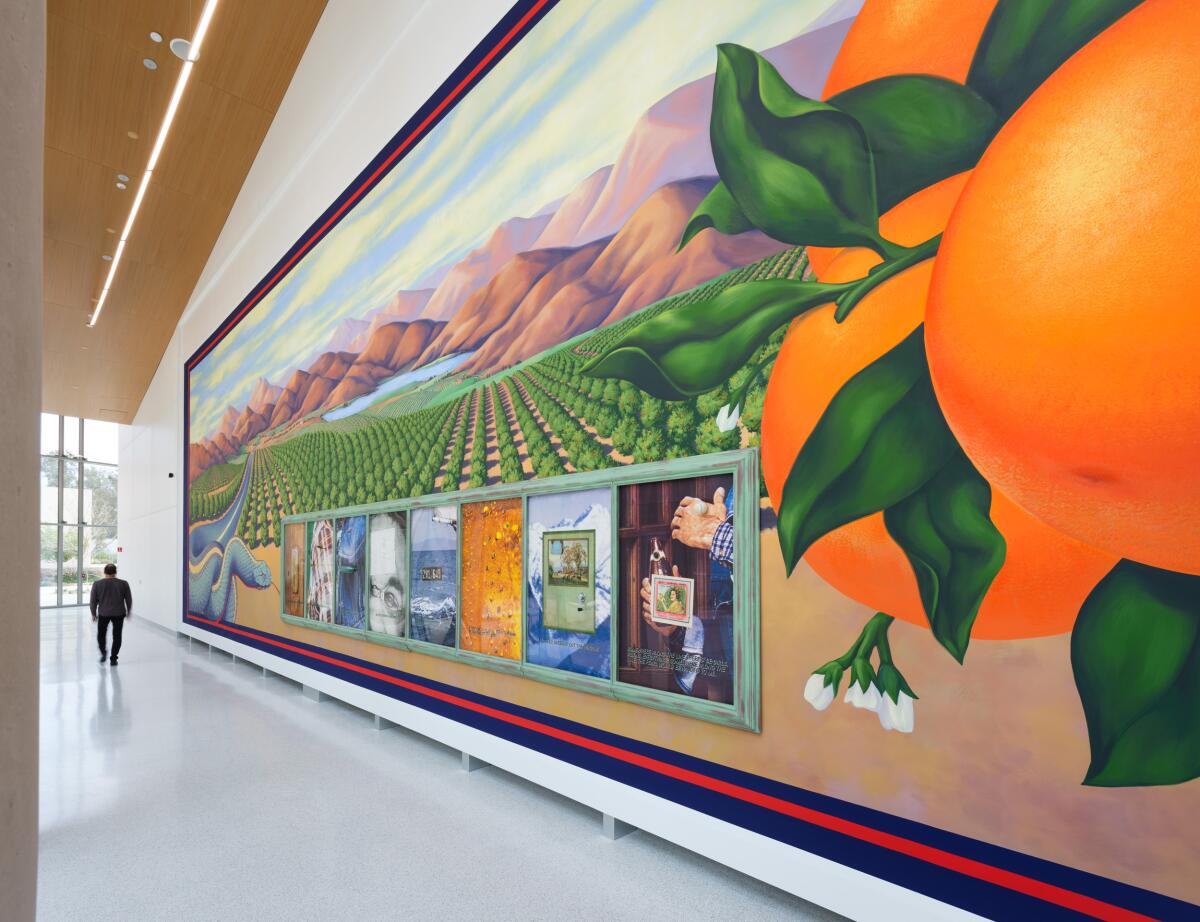
At the left, a two-lane blacktop highway morphs into an exquisite serpent, winding its way through verdant Eden — a gorgeously idealized California landscape worthy of a classic orange crate label. At the right, beneath an enormous trio of impossibly radiant oranges reminiscent of the lucky fruits that might come up in the windows of a Las Vegas slot machine, collages excerpt fragmented bits of Kerouac’s writing.
“Same Old Paradise” was shown in Los Angeles in 1992, a brilliant addendum to the traveling midcareer survey of the artist’s work from the Whitney Museum, which came to the Museum of Contemporary Art. After, Smith’s tour de force was rolled up and put in storage, where it languished for 30 years. Happily, its installation on an auditorium wall at UCSD’s new Sixth College campus was completed last year.
Like Smith’s namesake, her art exudes a period flavor. Rummaging through artifacts of the recent past, it is heavy on motifs from the 1940s and 1950s — a time just before and during the artist’s childhood, but also the tumultuous, transitional early years of modern American art’s emergence onto a world stage.
After World War II, as American art rose in prominence while a ruined Europe picked itself up and began to dust itself off, the formalist literary prohibition and the assertion of a hierarchy of mediums had taken hold. Smith, summoning bracing “ma-chees-ma,” made art that is a pungent corrective. The retrospective is an absorbing thrill.
‘Alexis Smith: The American Way’
Where: Museum of Contemporary Art San Diego, 700 Prospect St., La Jolla
When: Thursdays-Sundays, through Jan. 29
Cost: $15-$25; guests 25 and younger are free
Info: (858) 454-3541, www.mcasd.org
More to Read
The biggest entertainment stories
Get our big stories about Hollywood, film, television, music, arts, culture and more right in your inbox as soon as they publish.
You may occasionally receive promotional content from the Los Angeles Times.
